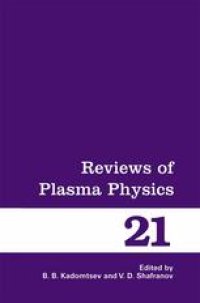
Ebook: Reviews of Plasma Physics
- Tags: Nuclear Physics Heavy Ions Hadrons, Theoretical Mathematical and Computational Physics, Atomic Molecular Optical and Plasma Physics
- Series: Reviews of Plasma Physics 21
- Year: 2000
- Publisher: Springer US
- Edition: 1
- Language: English
- pdf
Volume 21 provides the basis of the MHD theory in two extended reviews. The first review deals with high-temperature plasma equilibrium and stability in conventional stellarators (the steady state three-dimensional magnetic confinement systems). The second review considers the processes in the stationary plasma thrusters (SPT) created by one of the authors, A.I Morozov.
In spite of the three-dimensional nature of stellarators, the author of the review, V.D. Pustovitov, has been able to give a concise presentation of basic ideas and results of the rather complicated theory of stellarators, both for specialists and for students in this field.
The results of experimental and theoretical investigations of a new type of discharge device, SPT, are presented in the second review. Plasma thrusters generate quasi-neutral multi-ampere streams of ions with particle energies of 50 - 1000eV. They are most widely known as electric propulsion thrusters for spacecraft, and have been mounted onboard more than 50 Russian satellites. In addition, the SPTs are now used in technological systems for processing the surface layers of various products.
Volume 21 provides the basis of the MHD theory in two extended reviews. The first review deals with high-temperature plasma equilibrium and stability in conventional stellarators (the steady state three-dimensional magnetic confinement systems). The second review considers the processes in the stationary plasma thrusters (SPT) created by one of the authors, A.I Morozov.
In spite of the three-dimensional nature of stellarators, the author of the review, V.D. Pustovitov, has been able to give a concise presentation of basic ideas and results of the rather complicated theory of stellarators, both for specialists and for students in this field.
The results of experimental and theoretical investigations of a new type of discharge device, SPT, are presented in the second review. Plasma thrusters generate quasi-neutral multi-ampere streams of ions with particle energies of 50 - 1000eV. They are most widely known as electric propulsion thrusters for spacecraft, and have been mounted onboard more than 50 Russian satellites. In addition, the SPTs are now used in technological systems for processing the surface layers of various products.
Volume 21 provides the basis of the MHD theory in two extended reviews. The first review deals with high-temperature plasma equilibrium and stability in conventional stellarators (the steady state three-dimensional magnetic confinement systems). The second review considers the processes in the stationary plasma thrusters (SPT) created by one of the authors, A.I Morozov.
In spite of the three-dimensional nature of stellarators, the author of the review, V.D. Pustovitov, has been able to give a concise presentation of basic ideas and results of the rather complicated theory of stellarators, both for specialists and for students in this field.
The results of experimental and theoretical investigations of a new type of discharge device, SPT, are presented in the second review. Plasma thrusters generate quasi-neutral multi-ampere streams of ions with particle energies of 50 - 1000eV. They are most widely known as electric propulsion thrusters for spacecraft, and have been mounted onboard more than 50 Russian satellites. In addition, the SPTs are now used in technological systems for processing the surface layers of various products.
Content:
Front Matter....Pages i-viii
Theoretical Principles of the Plasma-Equilibrium Control in Stellarators....Pages 1-201
Fundamentals of Stationary Plasma Thruster Theory....Pages 203-391
Volume 21 provides the basis of the MHD theory in two extended reviews. The first review deals with high-temperature plasma equilibrium and stability in conventional stellarators (the steady state three-dimensional magnetic confinement systems). The second review considers the processes in the stationary plasma thrusters (SPT) created by one of the authors, A.I Morozov.
In spite of the three-dimensional nature of stellarators, the author of the review, V.D. Pustovitov, has been able to give a concise presentation of basic ideas and results of the rather complicated theory of stellarators, both for specialists and for students in this field.
The results of experimental and theoretical investigations of a new type of discharge device, SPT, are presented in the second review. Plasma thrusters generate quasi-neutral multi-ampere streams of ions with particle energies of 50 - 1000eV. They are most widely known as electric propulsion thrusters for spacecraft, and have been mounted onboard more than 50 Russian satellites. In addition, the SPTs are now used in technological systems for processing the surface layers of various products.
Content:
Front Matter....Pages i-viii
Theoretical Principles of the Plasma-Equilibrium Control in Stellarators....Pages 1-201
Fundamentals of Stationary Plasma Thruster Theory....Pages 203-391
....